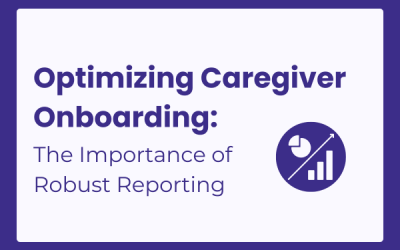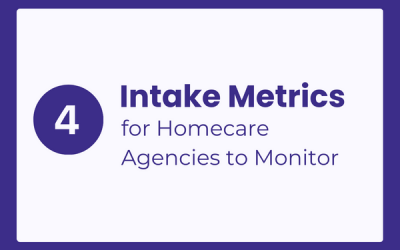An efficient, streamlined, and seamless caregiver onboarding process is critical to recruiting and retaining high-quality caregivers, which is essential for your agency’s success.
In this blog, we’ll discuss six onboarding metrics that homecare agencies should track to gain valuable insights into their onboarding process’s effectiveness and identify areas for improvement.
1. Application Completion Time
What is this? This metric measures the total time it takes for an applicant to fill out the initial application, from start to finish.
Why is it important? A lengthy or complex application can deter applicants from completing the process. Having a concise and user-friendly application leads to more completed applications and hires. Measuring the time it takes for applicants to complete an application will give you valuable insight to speed up the onboarding of new hires.
How do I calculate it? Use timestamps to record when the applicant begins and ends the application process, then calculate the difference to determine the total time it takes.
End timestamp – Begin timestamp = Application Completion Time
2. Time to Hire
What is this? This metric measures the total time it takes for an applicant to complete the entire hiring process.
Why is it important? A lengthy or complex hiring process can deter applicants from completing the process. Having a timely and straightforward process leads to more converted hires. Measuring the time it takes for applicants to get hired from initial contact to their first day of employment will give you valuable insight into identifying bottlenecks and opportunities for improvement.
How do I calculate it? Record when the applicant begins and ends the hiring process, then calculate the difference to determine the total time it takes.
Hiring Date – Candidate Created Date = Time to Hire
3. Yield Ratio
What is this? The yield ratio measures the percentage of applicants who successfully move from one stage in the hiring process to the next.
Why is it important? The yield ratio can be used to evaluate the effectiveness of various recruitment efforts. A low yield ratio may suggest a marketing effort isn’t attracting qualified candidates. It can also help identify bottlenecks and issues in the recruitment process, such as a drop after a particular stage in the application process.
How do I calculate it? Divide the number of candidates who successfully pass a hiring stage by the number of candidates who entered the stage and multiply by 100 to get the percentage.
(Number of candidates who passed a hiring stage / Number of applications who entered the stage) x 100 = Yield Ratio
4. Applicant-to-hire Ratio
What is this? The applicant-to-hire ratio measures the number of applicants you need to attract to fill a single job opening.
Why is it important? Tracking this metric enables you to assess recruitment marketing effectiveness and employer brand appeal. It helps determine the number of applications needed for achieving specific hiring goals.
How do I calculate it? Divide the number of applicants by the number of hires to determine the applicant-to-hire ratio.
Number of Applicants ÷ Number of Hires = Applicant-to-hire Ratio
5. Cost per Hire
What is this? Cost per hire measures the cost of recruiting, hiring, and onboarding new employees in a given time frame.
Why is it important? Measuring the cost per hire allows you to identify opportunities to streamline your onboarding process and reduce expenses without compromising quality or effectiveness. It encompasses various hiring costs, such as software, personnel, advertising, etc. By analyzing this metric, you can pinpoint areas where cost-saving measures can be implemented while maintaining a high standard of hiring practices.
How do I calculate it? Add up all the costs associated with recruiting, hiring, and onboarding new employees and divide by the number of hires.
(Recruitment cost + Hiring cost + Onboarding Costs) ÷ Number of Hires in a given time frame = Cost per Hire
6. Sourcing Effectiveness
What is this? Sourcing effectiveness measures the success rate of various sourcing channels in attracting qualified candidates.
Why is it important? By tracking this metric for different channels, you can make data-driven decisions regarding your recruitment strategy. You can allocate resources to the most effective channels and optimize your sourcing efforts to attract high-quality candidates efficiently.
How do I calculate it? Assess the success rate of each channel by calculating the number of qualified candidates out of the total candidates from that specific channel. This approach focuses on the ratio of successful candidates to the overall candidates sourced from each channel.
(Number of qualified candidates from a specific channel ÷ Total number of candidates from that channel) x 100 = Sourcing Effectiveness
Conclusion – Knowing Your Metrics is Half the Solution
Recruiting and hiring caregivers is one of the top challenges homecare agencies face today. Creating a strong hiring process that attracts suitable applicants is essential to address this challenge. A strong hiring process can be evaluated based on measurable metrics that provide evidence of its effectiveness.
Inflowcare offers a game-changing caregiver onboarding solution, empowering homecare agencies to streamline operations and achieve unparalleled success. Our cutting-edge platform provides invaluable insights into recruitment sources, applicant qualifications, and time-to-fill vacancies. By utilizing Inflowcare’s comprehensive capabilities, agencies can save time and resources while delivering an exceptional experience to caregiver applicants.
Embrace the power of metrics, embrace Inflowcare, and embark on a journey of optimized caregiver hiring, leading to remarkable outcomes and outstanding care. Request a demo today!


